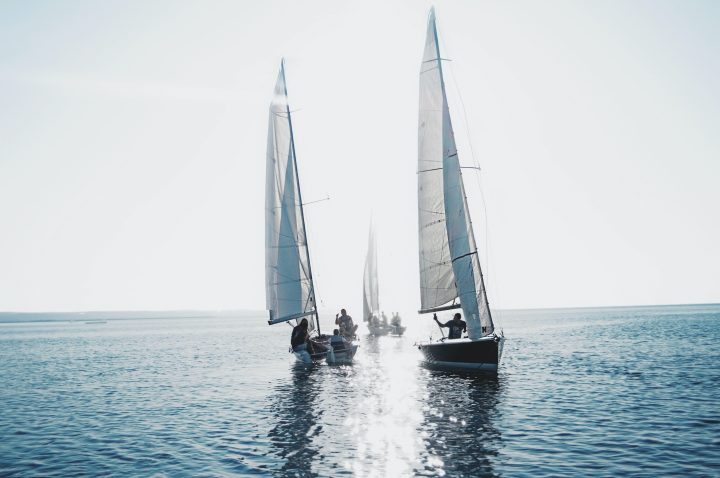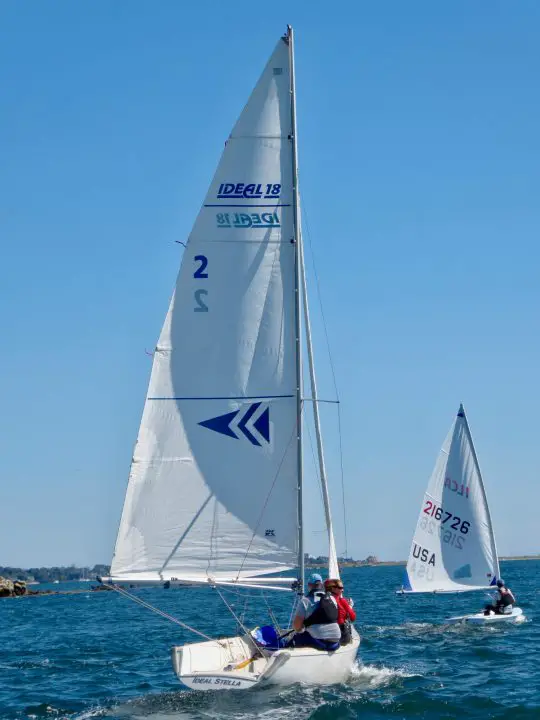Jibe ho! There are some sailing maneuvers that boaters deal with every day that seem pretty tricky to newcomers. Tacks and jibes are some of the most confusing concepts on a sailing vessel. Let’s look at some of the nuances of these two simple sailing maneuvers.

Table of Contents
- Definitions — Tack vs Jibe
- Tacks vs. Jibes In the Real World
- Factors and Dangers of Jibing a Boat
- Tack vs. Jibe Takeaways
Definitions — Tack vs Jibe
First, let’s start with some definitions of these sailing terms.
Both of these terms involve tacking a sailboat. Basically, tacking is the idea that a sailboat cannot sail directly into the wind. Ironically, it can’t go directly downwind very well, either. So, a sailboat will steer alternating zig-zag courses (called tacks) when sailing directly to windward or downwind.
Tacks are further identified by which side of the boat the wind direction is coming from. If the wind is coming over the port side and hitting the sails on the starboard side, the boat is said to be on the port tack. When the wind is coming over the starboard rail, the boat is on a starboard tack.
Tacking Defined
The art of getting the boat on the opposite tack in the opposite direction is a sailing maneuver called tacking.
When headed into the wind, tacking involves turning the boat through the eye of the wind and “coming about.” While the helmsman steers the boat onto its new course, the sail handlers must release the sheets on one side and bring them in on the other side, thereby switching which side of the boat the sails are on.
When tacking, the helmsman usually shouts, “Ready about!” or “Read to tack!” These tell the crew to prepare the lines and brace themselves for the maneuver.
Jibing Defined
First, one point of confusion is that jibe is often spelled gybe. Gybe is the British spelling, and jibe is the American way. Unfortunately, beyond spelling, neither country has formulated a method that works any better than the other!
Jibes are basically tacks but done downwind. Instead of turning the boat through the eye of the wind (0º apparent wind angle), the boat is steered through dead downwind (180º apparent wind angle).
The person at the helm usually shouts, “Ready to jibe!” to get the crew ready, and “Jibe ho!” to announce that it’s happening.

Tacks vs. Jibes In the Real World
Both tacks and jibes are regular parts of sailing. Technique-wise, jibing is a little tricker because of the mainsail.
Tacking is simple because the main is sheeted close to the center when headed into the wind. As you tack the boat, you can leave the main alone. Since it’s in the middle, it won’t move much from one tack to the other.
Instead, the sail handler’s attention is all on the headsail (jib or genoa), as the working jib sheet must be switched to the opposite side of the boat.
When sailing downwind, however, the boom is let out to be perpendicular to the boat. So when you jibe, the boom on a sailboat must cross to the other side.
Jibing means you’ve got to control the boom the entire way. Before turning for the jibe, the sail handler must trim the boom back to the boat’s center. Then, the boat is turned through the jibe, and as soon as the sail comes through the wind, the sheet is eased out to set the boom at the proper angle.
Through all of this, the headsail during the jib is generally ignored until last. When sailing dead downwind, the main will shadow the jib or genoa. Since it’s not doing anything, you can take care of headsail after handling the mainsail.
Factors and Dangers of Jibing a Boat
There are a few factors that make jibing trickier than tacking. The primary problem is that the boom—a huge horizontal pole—will have to cross over the boat. It’s a large, heavy object mounted at head height. In high winds, the boom swings surprisingly fast and forcefully. Head injuries or sending some unaware crew member over the side are real risks.
A crash jibe is an uncontrolled, accidental jibe that occurs without warning. The boom smashes from one side of the boat to the other, and the force of that can be immense when coupled with strong winds or big seas. Breaking things, tearing sails, or smashing the boom clean off the mast are possibilities. On a small boat, you can risk capsizing or getting knocked down.
For these reasons, sometimes it might be preferable just to bring the boat all the way around and tack it through the wind direction, thereby avoiding a jibe altogether.
Practical Ways to Mitigate the Risk of Accidental Jibes
For cruising sailors, it’s safe to say a crash jibe could represent a very bad day. Expensive stuff might break, or worse, someone might get hurt or thrown over. Therefore, it’s in the interest of cruising sailors to mitigate the risk of an accidental jibe as much as possible.
The first step would be to avoid sailing at very deep wind angles, especially when wind and sea conditions are changeable. Most boats don’t sail well beyond about 160º apparent wind angle, anyway. Save the fancy maneuvers like wing-on-wing sailing for a day when the seas are calm, and you can give it your full attention.
Next, there are some equipment additions you might consider. The first is a boom brake. Boom brakes are lines that run through a fitting on the boom that adds friction. It will not prevent a jibe, but if one occurs, it will cause the boom to move more slowly. So, they add a safety margin to allow people to get out of the way and to soften the loads imposed on the rest of your rig.
Finally, there are jibe preventors. A preventer is a line run from the boom’s aft end to the bow, holding the boom in place. The line will keep the boom from moving if the boat accidentally jibes. Preventers are important equipment when sailing offshore but take time to set up. They must be released and reset before and after every jibe. As a result, they are seldom rigged for day or coastal sailing.
The advantage of a boom brake over a preventer is that it can always be left in place. The one time you didn’t rig a preventer is inevitably the time you’ll accidentally jibe. At least in this case, you’ll have the brake working (hopefully).
Of course, for cruising sailors working long legs offshore, the right answer is that you really should have both a brake and a preventer rigged.
Tack vs. Jibe Takeaways
If you’re not much of a sailor, there’s one big takeaway here. If you hear “Jibe ho!” then you should duck down out of the way of the boom!
Why jibe instead of tack?
In sailing, both tacking and jibing are methods used to change a boat’s direction relative to the wind. The decision to either tack or jibe depends on the boat’s current course relative to the wind and the intended direction.
